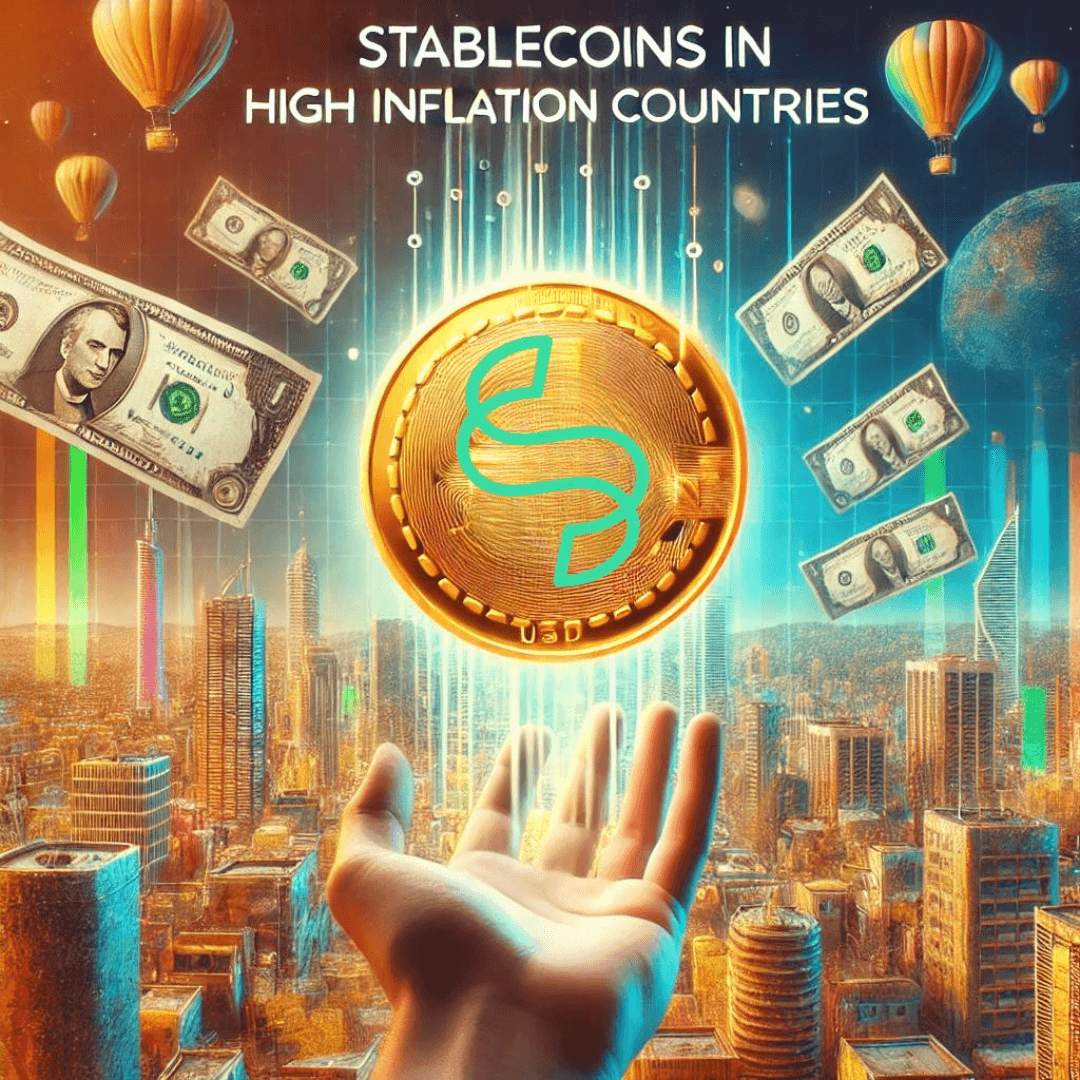October 25, 2024
As traditional currencies waver under the pressure of economic instability, stablecoins have stepped up as a reliable financial safety net. These digital currencies, pegged to assets like the US dollar or gold, offer a stable value, vital in volatile financial landscapes.
Countries battling sky-high inflation, such as Venezuela, Lebanon, and Turkey, are finding solace in stablecoins, using them to protect their savings and meet daily transaction needs.
Diving into this blog, you can expect to uncover the innovative stability mechanisms of stablecoins and their widespread adoption in regions with unpredictable currencies. From Nigeria to Argentina, the narrative unfolds around the growing role of stablecoins in global economic resilience, offering insights into their efficiency, accessibility, and the regulatory hurdles they face today.
Stablecoins as Financial Safety Nets
Stablecoins are digital currencies designed to maintain a stable value by pegging to assets like the US dollar or gold. In volatile financial markets, they offer a crucial layer of stability, acting as a hedge against inflation. This characteristic makes them particularly appealing in regions facing high inflation, where local currencies often depreciate rapidly.
In countries like Argentina and Venezuela, where inflation rates are exceptionally high, stablecoins have emerged as a vital tool for preserving value. For example, in Venezuela and Lebanon, people frequently opt for USD-backed stablecoins rather than more volatile cryptocurrencies like Bitcoin. These stablecoins provide a steady means to conduct everyday transactions amidst the challenging economic conditions. People across the world can often be seen actively taking part in such discussions such as the one here.
In Turkey, where inflation has soared to rates as high as 80% in the recent past, stablecoins are being leveraged by individuals and businesses alike to safeguard their savings. Certain stablecoins, like USDT on the Tron network, offer low transaction fees, making them an attractive option for users needing practical and cost-effective solutions.
For a broader understanding of the impact of stablecoins in emerging economies and how they function as financial safety nets, you might find this YouTube video insightful. The video explores the growing popularity of stablecoins and their role in mitigating inflationary risks worldwide.

Stability Mechanisms and Financial Innovation
Stablecoins in Unstable Economic Environments
Stablecoins, equipped with diverse stability mechanisms, represent a significant financial innovation, especially for combating hyperinflation. This section will explore the ways in which these cryptocurrencies maintain their value in unstable economic environments.
Stablecoins employ either reserve backing or algorithmic control to ensure their value doesn't fluctuate. Stablecoins like USDT and USDC peg themselves to fiat currencies such as the US Dollar by maintaining a 1:1 reserve. This means that issuers back every coin with a dollar or its equivalent, like US Treasuries, providing a high level of trust among users.
Algorithmic stablecoins use algorithms and smart contracts to automatically adjust their supply in response to market demands.
By employing techniques like rebasing or seigniorage, they can adapt to price changes and maintain their peg.
Hybrid models combine these two approaches, using both reserves and algorithms to navigate market fluctuations effectively.
Decentralized finance, or DeFi, adds another dimension to the stability of stablecoins by promoting liquidity and user engagement. DeFi platforms incorporate stablecoins into liquidity pools and yield farming, supporting their use and integration into the broader financial ecosystem.
In hyperinflationary environments, such as in Argentina, stablecoins present a crucial alternative. Many people convert their earnings into stablecoins pegged to the dollar to protect against the devaluation of their local currency. By utilizing these cryptocurrencies, individuals can preserve the purchasing power of their money, making them a reliable option amid financial instability.
In this context, USDs - a fully collateralized stablecoin - offers a unique advantage for people in high inflation-affected countries by providing a stable, USD-pegged asset with an additional benefit: an autoyield feature that automatically grows holdings - just by holding it in the crypto wallet.
Unlike popular stablecoins like USDT, which maintain stability but lack any built-in yield, USDs accrues a competitive APR ranging from around 8% to 25%, compounding automatically without requiring extra transactions or fees. This feature makes USDs an effective hedge against inflation and a tool for wealth growth, allowing users to preserve and even increase their purchasing power in regions where traditional currencies are rapidly losing value.
Learn more about it HERE.

Inflation Hedge with Stablecoins in Africa
Use of USDT in Nigeria
Rising inflation means many Nigerians are in need of stable financial tools. The local currency, the Naira, is constantly losing value, prompting residents to explore other avenues for preserving their wealth. This is where stablecoins like USDT come into play.
Pegged 1:1 to the US dollar, USDT offers Nigerians a reliable store of value. It's not just about saving money; it's about maintaining its worth.
Emerging Countries in Africa with Increasing Stablecoin Adoption
This phenomenon isn't exclusive to Nigeria; it's a significant trend across Africa. Nigeria saw over $59 billion in crypto transactions from July 2023 to June 2024, with stablecoins being pivotal. In January 2023, stablecoin transactions exceeded $3 billion.
The trend transcends borders with countries like Kenya witnessing a similar pattern. Nations, especially in sub-Saharan Africa, are leaning towards stablecoins to combat economic instability and currency devaluation.
Platforms like Yellow Card make stablecoins easily accessible, supporting transactions ranging from savings to international dealings.
Stories from individuals who now earn in USDC instead of the Naira, reveal stablecoins' tangible benefits in mitigating economic upheaval. Adoption is driven by a desperate need for stable monetary tools in the face of inflation and volatile local currencies.
Furthermore, platforms like Ivorypay simplify how businesses and individuals integrate stablecoins into their financial practices. As more Africans turn to these digital assets, it evidences a shift toward financial inclusion. Stablecoins provide affordable, accessible financial tools that reach unbanked or underbanked populations. They offer an alternative amidst stringent foreign exchange regulations and economic volatility.
The Impact of Stablecoins on Argentina's Economy
Argentina is currently navigating a turbulent economic landscape defined by hyperinflation and currency devaluation. With inflation rates sometimes crossing a staggering figure of 200%, the Argentine peso's value has plummeted, triggering financial instability and heightened poverty levels across the nation.
In response to these economic calamities, many Argentinians are turning to stablecoins as a refuge to safeguard their purchasing power and counter the peso's volatility.
Users have widely adopted Stablecoins such as Tether (USDT) because they can maintain a stable value relative to the volatile local currency.
As noted in a Reddit thread, these digital assets are particularly appealing in countries like Argentina, where traditional avenues for acquiring foreign currencies, such as the US dollar, may present risks like scams and counterfeit issues.
A Chainalysis report quantifies this surge in stablecoin utilization, showing a dramatic increase in the monthly trading volumes against the Argentine peso (ARS).
For instance, at times when the ARS faltered to less than $0.004 in July 2023, the subsequent month saw stablecoin trades leap to over $1 million.
By December of the same year, when the ARS fell to $0.002, transactions exceeded $10 million. This trend continued into 2024, with peaks reaching over $60 million in trading volume by March.
The report further highlights that Argentina's stablecoin transactions constitute 61.8% of the region's crypto activities, surpassing the 44.7% global average.
Despite the lack of robust regulatory oversight, this situation offers both freedom and risks for users engaging in cryptocurrency transactions.
However, Argentina's economic vision, which includes options for dollarization, reflects a proactive approach to embracing foreign currencies and stabilizing the economy through policy shifts that align with the rising adoption of stablecoins.
Furthermore, Argentina leads its Latin American peers in the share of stablecoin transactions, with involvement reaching up to 60% on platforms like Bitso.
The social impact is profound, as these digital currencies not only protect wealth but also potentially reduce inflation-induced poverty, emphasizing their crucial role in the Argentine financial landscape.

The Impact of Stablecoins on Argentina's Economy
In Argentina, the role of stablecoins has become increasingly significant as they offer a reliable way to preserve wealth and facilitate everyday transactions. Faced with soaring inflation rates and the devaluation of the Argentine peso, stablecoins provide an alternative that many Argentinians are turning to in order to shield themselves from financial instability.
Economic Instability and Currency Fluctuations
Argentina has been grappling with severe economic issues, where the local currency's value often takes a hit, making it hard for people to save or invest. As a response, stablecoins, particularly those pegged to the US dollar, have risen in popularity. They are being explored for large purchases and real estate transactions, as they can help circumvent the risks associated with pesos.
Everyday Transactions and Wealth Preservation
Stablecoins in Argentina support both large transactions and daily financial activities, maintaining purchasing power amid the peso's decline. This reflects a shift towards digital assets in high-inflation settings.
The increasing adoption underscores stablecoins' role in providing economic stability in Argentina. They help navigate financial instability and protect assets from currency fluctuations.
Stablecoins and Their Challenges
Financial Inclusion and Accessibility
Stablecoins are easily accessible to anyone with an internet connection and a crypto wallet. This simple requirement makes them particularly valuable for underbanked regions where traditional financial services are lacking.
They serve as a bridge over the financial gaps left by conventional banks, especially in areas with underdeveloped banking infrastructure. However, there are still hurdles to overcome. For example, regulations such as Know Your Customer (KYC) requirements can impact accessibility.
These regulations are in place to prevent illegal activities, but they can create barriers for people who lack formal identification or access to necessary documentation. As a result, some individuals may be excluded from utilizing these digital assets.
Despite these challenges, the potential of stablecoins to enhance financial inclusion shouldn't be understated. They present a unique opportunity to democratize access to financial services and improve economic stability in regions affected by high inflation.
Transaction Efficiency of Stablecoins
Blockchain technology ensures stablecoin transactions are swift and cost-effective.
Stablecoins transform financial transactions in high-inflation areas where traditional transfers are costly and slow. By eliminating intermediaries, stablecoins provide a method to execute transactions directly on the blockchain, ensuring that transfer of funds is not only swift but also highly cost-effective.
Stablecoins circumvent delays and high fees associated with traditional money transfers.
Stablecoins offer a profound advantage by bypassing the cumbersome processes involved in conventional banking systems. For instance, a typical cross-border money transfer might take days to process and incur hefty fees.
In contrast, a stablecoin transaction, regardless of the country's banking infrastructure, usually concludes in mere minutes with minimal fees, often amounting to just a few cents. This makes stablecoins a very attractive option for people seeking affordable and efficient remittance solutions.Efficiency in transactions makes stablecoins attractive for everyday and cross-border use.
In countries like Mexico, the deployment of stablecoins in the remittance market widens the accessibility of seamless financial services. Unlike traditional methods that necessitate days of waiting and high costs, stablecoins facilitate nearly instantaneous transfers from anywhere in the world.
This alone makes them invaluable for individuals and businesses needing quick access to money. Moreover, the 24/7 accessibility ensures users can perform transactions and manage their finances whenever necessary, independent of bank operating hours. The capability of stablecoins to perform efficiently in crisis situations further underscores their reliability as a modern financial tool.

Stablecoins, often celebrated as financial lifelines in high inflation regions, are increasingly hindered by a maze of regulatory challenges. These challenges are not minor; they significantly impact the accessibility and acceptance of stablecoins as viable financial instruments.
Measures like transaction caps and Know-Your-Customer (KYC) requirements are commonly implemented to prevent illicit activities. However, these measures can create hurdles for those in high inflation environments, making it harder to access stablecoins.
These regulatory requirements can essentially lock out individuals who stand to benefit the most from the stability and efficiency offered by stablecoins.
The lack of uniformity in the global regulatory landscape adds another layer of complexity. For instance, the European Union's Markets in Crypto-Assets (MiCA) legislation is a step in the process of creating a unified regulatory approach.
Smaller issuers, particularly in resource-constrained areas, might struggle to meet these requirements, potentially limiting the coins' functionality.
Brazil’s Progressive Regulation
In juxtaposition, Brazil represents how progressive regulation can encourage stablecoin adoption by establishing positive precedents. On the other hand, excessive regulation risks stifling innovation and potentially driving stablecoin activities underground, where security is less assured.
Users often fear that heavy-handed regulation may erode the core benefits of stablecoins, such as ease of access and low transaction costs.
To overcome these barriers, international cooperation and clear guidelines are essential. Organizations like the Financial Stability Board and the G7 Working Group on Stablecoins are actively working towards establishing consistent international standards.
Aligning these efforts is crucial for enabling stablecoin use efficiently in high inflation countries, supporting a balance between regulation and innovation without compromising financial stability.
The Future of Stablecoins in Combating Inflation
Stablecoins play a pivotal role in providing financial stability in high inflation environments. Their design, which anchors them to stable assets or currencies, ensures a buffer against the rampant inflation that plagues many economies.
With easy accessibility via smartphones and the internet, stablecoins offer a democratized approach to global financial systems.
Core Advantages
Stablecoins allow both individuals and businesses to bypass the tumultuous nature of traditional currency values.
Not only do they secure value, but they also enable participants to save and transact without fear of devaluation, fostering an environment where financial inclusion is enhanced.
However, as these digital currencies gain traction, it is imperative to address the regulatory challenges that come with them. These include potential risks of money laundering and fraud, which necessitate a carefully crafted regulatory framework.
Policymakers and innovators must collaborate to strike a balance—ensuring security without hindering innovation. This collaboration is crucial to fully harness the potential of stablecoins in combating inflationary pressures without compromising the integrity of financial systems.




